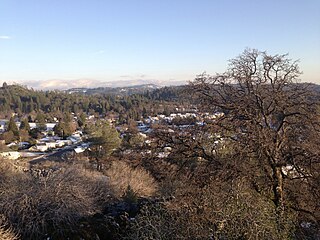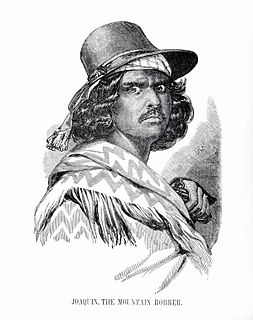
The California Gold Rush (1848–1855) began on January 24, 1848, when gold was found by James W. Marshall at Sutter's Mill in Coloma, California. The news of gold brought approximately 300,000 people to California from the rest of the United States and abroad. The sudden influx of gold into the money supply reinvigorated the American economy, and the sudden population increase allowed California to go rapidly to statehood, in the Compromise of 1850. The Gold Rush had severe effects on Native Californians and resulted in a precipitous population decline from disease, genocide and starvation. By the time it ended, California had gone from a thinly populated ex-Mexican territory, to having one of its first two U.S. Senators, John C. Frémont, selected to be the first presidential nominee for the new Republican Party, in 1856.
Chilli or chili may refer to:

Murphys, originally Murphys New Diggings then Murphy's Camp, is an unincorporated village located in the foothills of the Sierra Nevada mountains in Calaveras County, California, United States. A former gold mining settlement, the main street today is lined with over two dozen wine tasting rooms and surrounded by local vineyards. The town is popular among tourists and transplants from the Central Valley and the San Francisco Bay Area. Murphys is also known by its colloquial nickname as "Queen of the Sierra" and is one of the more affluent communities in Calaveras County.

State Route 49 is a north–south state highway in the U.S. state of California that passes through many historic mining communities of the 1849 California gold rush. Highway 49 is numbered after the "49ers", the waves of immigrants who swept into the area looking for gold, and a portion of it is known as the Gold Country Highway. This roadway begins at Oakhurst, Madera County, in the Sierra Nevada, where it diverges from State Route 41. It continues in a generally northwest direction, weaving through the communities of Goldside and Ahwahnee, before crossing into Mariposa County. State Route 49 then continues northward through the counties of Tuolumne, Calaveras, Amador, El Dorado, Placer, Nevada, Yuba, Sierra, and Plumas, where it reaches its northern terminus at State Route 70, in Vinton.

Dog Town is a ghost town in Mono County, California. Today, Dog Town is a defunct gold rush era town in Mono County, California. It is located at 38°10′13″N119°11′51″W, on Dog Creek, near the junction of Clearwater and Virginia Creeks, about 6 miles (10 km) south-southeast of Bridgeport, at an elevation of 7057 feet.

Sandy Gulch is a small community in Calaveras County, California, just southwest of West Point on State Route 26. It lies at an elevation of 2592 feet above sea level and is located at 38°22′49″N120°31′58″W. The community is in ZIP code 95248 and area code 209.

Campo Seco is an unincorporated community in Calaveras County, California. It sits at an elevation of 564 feet above sea level and is located at 38°13′38″N120°51′12″W. The community is in ZIP code 95226 and area code 209.

Jenny Lind is an unincorporated community in Calaveras County, California. It lies at an elevation of 253 feet and is located at 38°6′N120°52′W. The community is in ZIP code 95252 and area code 209.

Glencoe is an unincorporated community in Calaveras County, California. It lies at an elevation of 2749 feet and is located at 38°21′15″N120°35′06″W. The community is in ZIP code 95232 and area code 209.

The Shores of Poker Flat is an unincorporated community in Calaveras County, California. It lies at an elevation of 584 feet above sea level and is located at 37°54′11″N120°34′56″W, on the shore of the Tulloch Reservoir. The community is in ZIP code 95228 and area code 209.

Jesus Maria is an unincorporated community in Calaveras County, California. It lies at an elevation of 1043 feet and is located at 38°17′08″N120°38′51″W. The community is in ZIP code 95222 and area code 209.

Paloma is an unincorporated community in Calaveras County, California. It lies at an elevation of 1362 feet and is located at 38°15′34″N120°45′48″W. The community is in ZIP code 95252 and area code 209.

Chilean Americans are Americans who have full or partial origin from Chile.
William Greeneberry "Green" Russell (1818–1877) was an American prospector and miner.

Whiskeytown is an unincorporated community in Shasta County, California, United States. The ZIP Code is 96095. The community is inside area code 530. Although once a bustling mining town, there are very few people living in Whiskeytown as of today. The entire town of Whiskeytown was flooded to make way for Whiskeytown Lake in 1962. The ZIP Code of 96095 is now defunct as it has been taken over by ZIP Code 96033 in nearby French Gulch. The town of Whiskeytown is now properly part of French Gulch as the original post office and store closed after 40 years. But Whiskeytown appears on many maps. All that remains is the relocated store, a few residences, mostly occupied by National Recreation Area personnel, and old mines that are above the water level of the lake. Whiskeytown is registered as a California Historical Landmark.

Alabama Hill is an unincorporated community in Calaveras County, California. It lies at an elevation of 2972 feet. Miners from Alabama settled here in 1849 and named the place after their native state.

Rich Gulch is an unincorporated community in Calaveras County, California, 5 miles (8.0 km) east-northeast of Mokelumne Hill. It lies at an elevation of 1903 feet.
Greasertown is a former settlement in Calaveras County, 4 miles (6.4 km) west of San Andreas, on the west side of the Calaveras River. The town was rumored to have received its name due to what one-time resident and schoolteacher Margaret Blanc described as “a straggling settlement … with canvas tents and wooden shanties of which it consisted the abodes of … Mexicans who packed and drove mules up to the mines with provisions for the diggers at work on the banks on the Mokelumne and Calaveras.” Blanc said the town was in fact diverse, with many nationalities represented. She wrote that the town included, “About 30 children made up of all classes, nationalities and ages.”
Chili Bar is a former settlement and mining camp in El Dorado County, California. It was located on the South Fork of the American River 4.5 miles (7.2 km) east-southeast of Coloma.
Middle Bar is a former mining town on the Mokelumne River in Amador County, California. It is a California Historical Landmark.











